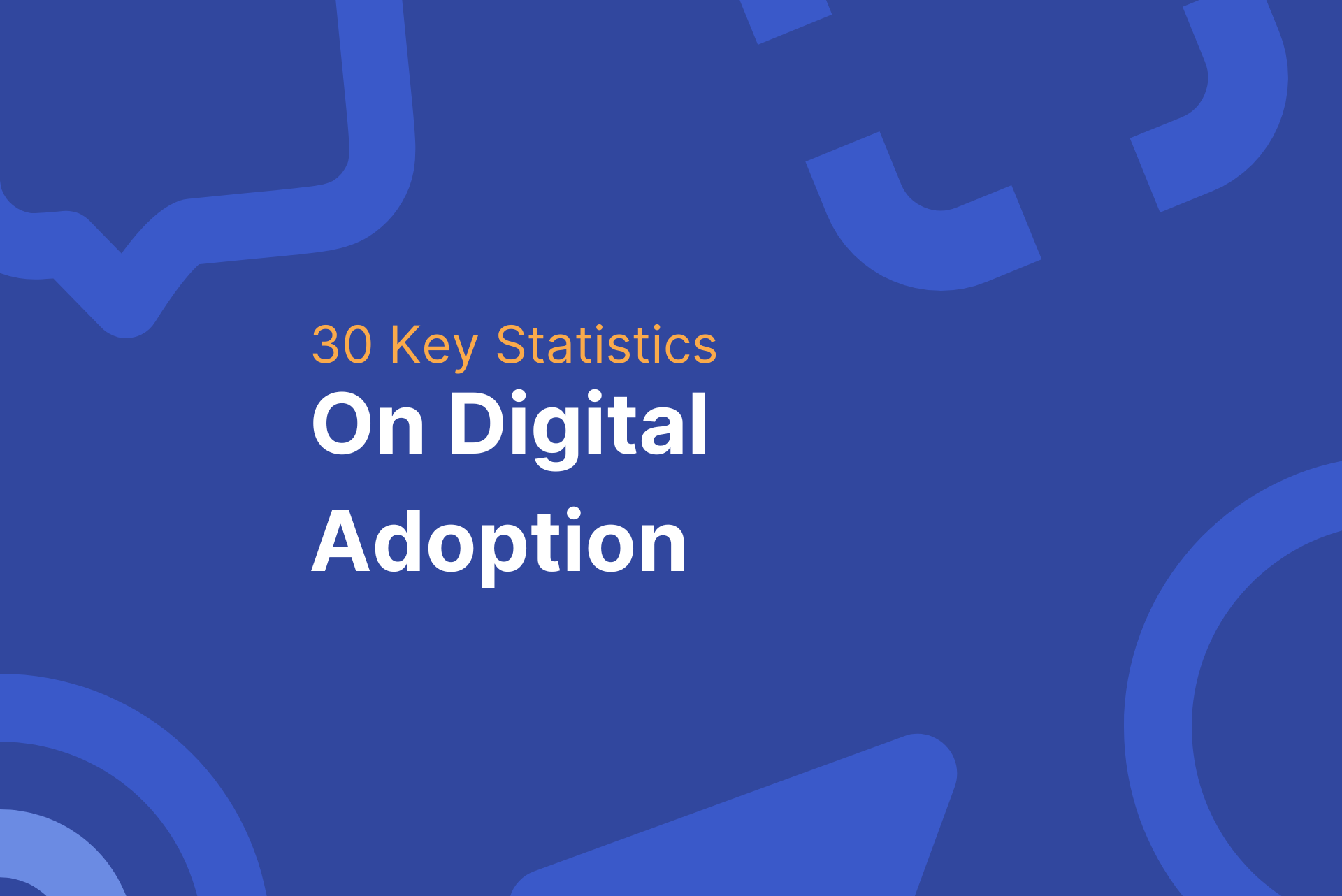The pandemic has accelerated digital adoption across all industries so we are covering some of the key statistics on digital adoption. Global spending is expected to reach a staggering $2.8 trillion by 2025 – more than double the amount allocated in 2020. With worldwide spending on digital transformation already expected to reach 2.4 trillion in 2024, it is noteworthy that according to Forbes, 84% of digital transformation projects fail. In fact, in the US alone, more than $30 billion is wasted on software annually.
On the plus side – if businesses do invest in digital adoption they can expect increased productivity, greater customer and employee engagement, and higher levels of profitability overall.
We’ve seen two years’ worth of digital transformation in two months.
Satya Nadella, CEO, Microsoft
Infographic on key statistics on digital adoption
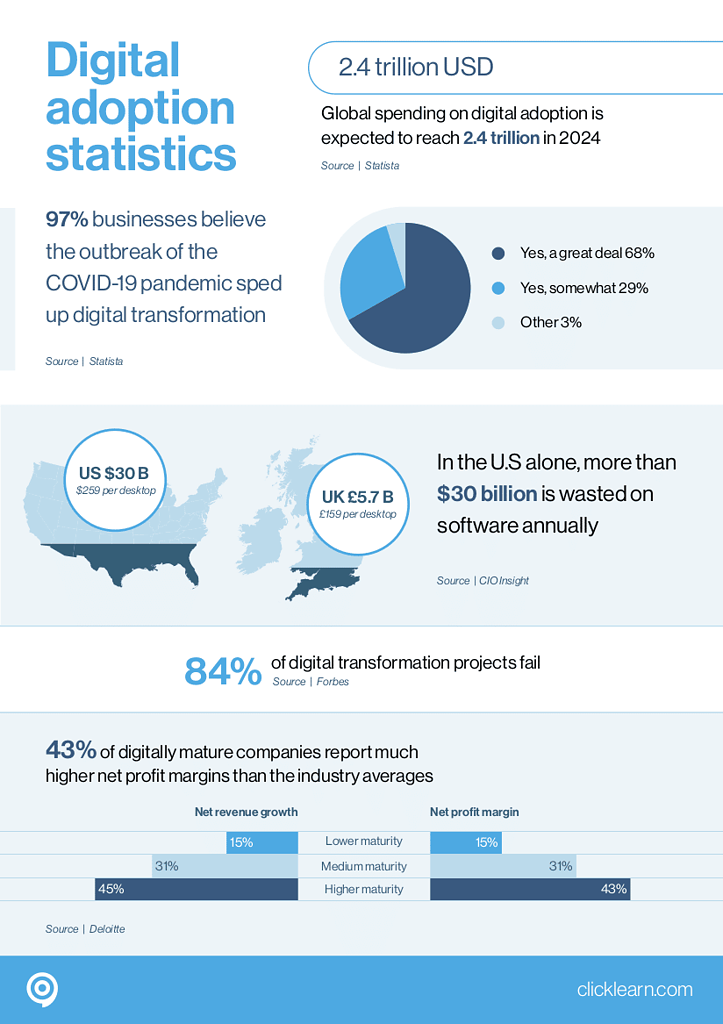
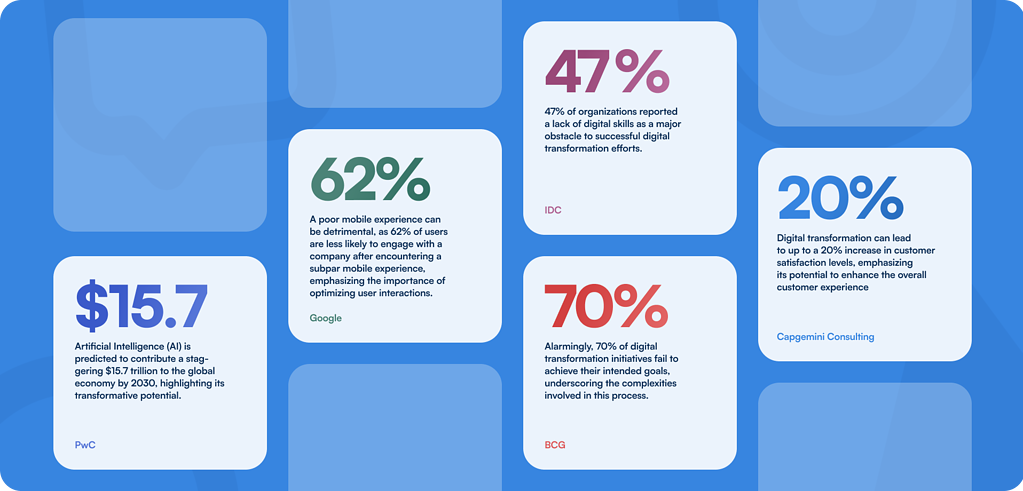
Top digital transformation and digital adoption statistics
Digital transformation has become an imperative for businesses in the digital era. From the importance of investing in digital transformation to the challenges faced, user engagement trends, and emerging technologies, the following digital transformation statistics provide valuable insights for organizations seeking to navigate the ever-evolving landscape of corporate software training.
Market growth and adoption: Digital transformation statistics, trends, and forecasts
The digital transformation market is set for rapid growth in the coming years:
- The global digital transformation market is expected to expand to $1,009.8 billion by 2025, up from $469.8 billion in 2020, reflecting a compound annual growth rate (CAGR) of 16.5% (Quixy).
- By 2026, worldwide spending on digital transformation is projected to reach $3.4 trillion (Statista).
- Another forecast suggests that the digital transformation market size will grow at a CAGR of 19.1%, from $521.5 billion in 2021 to $127.5 billion by 2026 (Markets and Markets).
- The World Economic Forum projects that digital transformation could add $100 trillion to the global economy by 2025 (Quixy).
- Investment in digital transformation is expected to nearly double, rising from $1.8 trillion in 2022 to $2.8 trillion by 2025 (Statista).
- Leadership plays a critical role in success: Organizations with an engaged Chief Digital Officer (CDO) are six times more likely to succeed in their transformation efforts (Prophet).
Digital transformation spending forecasts
As digital transformation becomes integral to business strategy, spending in this area continues to rise:
- In 2022, global spending on digital transformation was projected to hit $1.6 trillion, with expectations for it to grow to $3.4 trillion by 2026 (Statista).
- By 2025, spending is forecasted to reach $2.8 trillion, marking significant growth in the adoption of digital initiatives (Markets and Markets).
- The World Economic Forum has predicted that digital transformation could generate up to $100 trillion in value for society and industry by 2025 (Quixy).
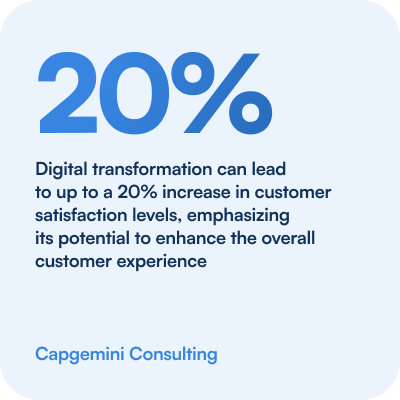
Current business adoption of digital transformation
Today’s businesses recognize that digital transformation is essential for long-term success:
- 91% of companies are engaged in some form of digital initiative, and 87% of senior business leaders consider digitalization a top priority (Gartner).
- 89% of businesses have adopted or plan to adopt a digital-first strategy, further cementing the importance of digital transformation (Statista).
- In the post-pandemic world, 37% of CEOs view leading digital transformation projects as one of their top agendas, alongside improving remote work capabilities (Statista).
Key trends in digital transformation
Emerging technologies are leading the charge in digital transformation:
- By 2024, 60% of data used in AI will be artificially generated, a major increase from the mere 1% in 2021 (Gartner).
- 60% of companies aim to become composable businesses by 2025, helping them outpace competitors in deploying new features by 80% (Gartner).
Cloud adoption and emerging technologies
Cloud adoption continues to grow, driven by emerging technologies:
- The global cloud security market is expected to rise from $40.7 billion in 2023 to $62.9 billion by 2028, with a CAGR of 9.1% (Gartner).
- AI spending is predicted to increase to $309.6 billion by 2026, up from $58.3 billion in 2021 (Markets and Markets).
- The global cloud storage market is anticipated to exceed $390 billion between 2021 and 2028 (Fortune Business Insights).
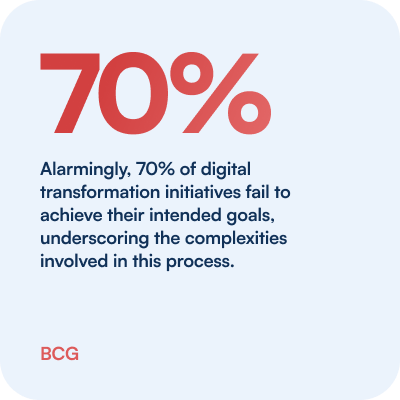
Customer experience in digital transformation
Customer experience is at the heart of digital transformation efforts, offering companies a competitive edge:
- 54% of transformation efforts focus on modernizing customer touchpoints, while 45% aim to enhance infrastructure (Prophet).
- After a negative experience, 86% of customers are unlikely to return to a brand they previously enjoyed (PwC).
- By 2028, the customer experience management market is expected to grow from $11.6 billion to $29.8 billion, reflecting the increasing importance of delivering a seamless customer experience (Statista).
Omnichannel approach and customer retention
An omnichannel approach, providing a consistent experience across all customer touchpoints, is essential for retaining customers and driving revenue growth:
- The number of companies investing in omnichannel experiences has surged to over 80%, up from just 20% (PwC).
- 63% of retailers plan to invest more in data analytics and business intelligence, while 35% will focus on artificial intelligence (Top Business Tech).
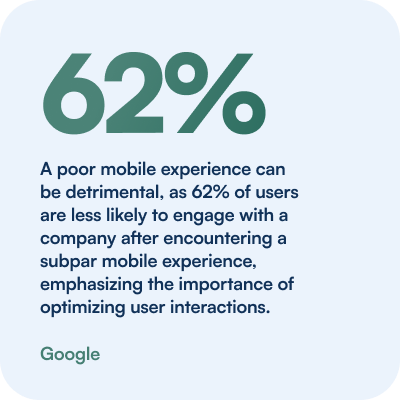
Digital transformation failures
Despite its potential, many digital transformation projects struggle to succeed:
- 73% of companies report gaining no business value from their digital transformation efforts (Everest Group).
- 70% of digital transformation initiatives fail to achieve their goals, often due to resistance from employees or inadequate change management strategies (Boston Consulting Group).
- Only 16% of employees feel that their company’s digital transformation has led to long-term productivity gains (McKinsey).
Digital transformation challenges
Businesses face numerous challenges in their digital transformation efforts, such as:
- 28% of companies still view digital transformation as a cost center, and 29% struggle to find reliable data to prove ROI (Prophet).
- 75% of retailers cite the availability of skilled talent and the complexity of implementation as key obstacles (Fujitsu).
- Over 33% of CIOs anticipate challenges in finding the right talent, especially in cybersecurity and data science (CIO Dive).
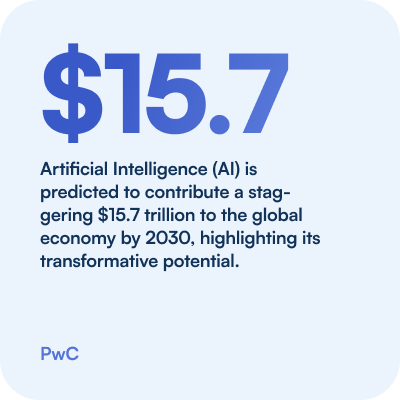
Digital transformation and the job market
Digital transformation is reshaping the job landscape, creating both challenges and opportunities for businesses:
- 54% of hiring managers acknowledge the importance of working with workforce development organizations to prepare employees for technological advancements (Salesforce).
- 41% of organizations will emphasize communication and emerging technology skills for remote work, while 42% plan to increase efforts to upskill and reskill their existing workforce (CompTIA).
- By 2030, experts predict that automation will eliminate 29% of jobs but simultaneously contribute 13% to job creation (World Economic Forum).
- The World Economic Forum projects that 50% of employees will need significant reskilling by 2025 as industries shift toward digital-first business models (Quixy).
Digital transformation in small and medium-sized enterprises (SMEs)
For small and medium-sized enterprises (SMEs), digital transformation is becoming increasingly essential for maintaining competitiveness and operational efficiency:
- 60% of midsize enterprises are expected to retain on-premise workloads until at least 2025 (Gartner).
- 77% of small businesses utilize social media to enhance brand recognition, provide customer support, and drive sales (SCORE).
- A survey revealed that 57% of small business owners feel the need to improve their IT infrastructure to optimize operations (Statista).
- 92% of SMEs believe that digital transformation is crucial for their business’ success (Statista).
Digital transformation and the environment
As digital transformation progresses, it also plays a key role in promoting sustainability and reducing environmental impact:
- By optimizing processes and reducing paper usage, digital transformation can help businesses reduce their environmental footprint by up to 10% (IDC).
- The logistics industry is expected to spend $84.6 billion on digital transformation initiatives by 2027, with much of this investment focused on reducing environmental impact through more efficient processes (Statista).
Industry-specific digital transformation statistics
Digital transformation impacts different industries in unique ways. Here’s a look at how various sectors are adopting and benefiting from digital transformation initiatives:
Retail
- 71% of retail businesses agree that digital transformation is crucial for their technology strategy (Fujitsu).
- 63% of retailers expect to increase their spending on data analytics and business intelligence, while 35% will focus more on artificial intelligence (Gartner).
Healthcare
- 95% of healthcare organizations have implemented or plan to implement a digital-first business strategy (IDG).
- The use of telehealth skyrocketed from 11% to 76% during the COVID-19 pandemic, and 37% of consumers are likely to continue using telehealth services in the future (McKinsey).
- The global healthcare AI market is expected to generate more than $34 billion in revenue by 2025 (BusinessWire).
Manufacturing
- The manufacturing sector’s digital transformation was valued at $263 billion in 2020 and is projected to reach $767 billion by 2026, with a growth rate of 19.48% (Mordor Intelligence).
- 86% of manufacturing firms report that just one hour of system downtime can cost them at least $300,000, making digital transformation crucial for operational continuity (ITIC).
Financial services and insurance
- By 2025, 25% of insurance industry processes are expected to be automated using AI and machine learning technologies (McKinsey).
- Three-quarters of banks have launched digital transformation initiatives, with 46% of these banks reporting they are at least halfway through their strategy (Cornerstone Advisors).
Human resources and learning & development
- By 2030, analysts predict that automation will eliminate 29% of jobs, but it will also contribute to the creation of new roles, particularly in areas requiring digital skills (Forrester).
- The World Economic Forum states that 54% of all employees will need significant reskilling by 2025 due to shifts in digital processes (Statista).
Get the most out of your technology adoption
Taking care of everything from documentation, onboarding, localization, and beyond, organizations worldwide trust ClickLearn to bring new technologies to the end users in a digestible way. Avoid technological disruption and increase operational efficiency with the right digital adoption solution.
